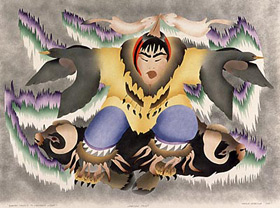Holman’s Graphic Art

Shaman Dances to Northern Lights 1991
Mary K. Okheena
stencil on paper, PWP 1/3 56.3 x 76.1 cm
Collection of The Winnipeg Art Gallery
I’ve been exploring this site with much pleasure: Holman: Forty Years of Graphic Art. Holman is a community located in Arctic Canada that is well-known for its graphic art. The site is based on an exhibition in 2002 of that name at the Winnipeg Art Gallery in Winnipeg, Canada, home to the largest collection of contemporary Inuit art in the Western world. (Back when I was living in Winnipeg in my youth, I saw several Inuit art exhibitions there.)
This excellent site features extensive information about life in Holman. A growing population in Holman and the demise of trapping as a source of income were key factors in the development of the arts and crafts industry. Drawing, printmaking, sculpture, and crafts provide an income for Holman artists. Read about the history of printmaking in Holman and the short biographies of the featured print artists. Note the useful descriptions of printmaking techniques along with the fascinating short videos of some of the artists demonstrating their techniques. Of course, the highlight is the gallery of works. Finally, don’t miss reading the wonderful story of The Blind Boy and the Loon, as an example of their story-telling tradition.
(Thanks to Print Australia, or now called bellebyrd for this great link.)
August 26, 2005 in Culture, Other artists, Printmaking by Marja-Leena
Ihana kuva. Pidän kovasti inuit-taiteesta. OLen ajatellut käsitellä ensi kuussa etnisiä käsitöitäni ja niiden taustaa. Nyt on tietokoneongelmia ja täytyy käyttää pelkkiä Doverin kuvia. Minusta on hauskaa käydä katsomassa blogiasi.
Pirkko
Hei Pirkko! Kiitos että tykkäät käydä katsomassa! On mukava saada tänne kommenti suomeksi ensimäisen kerran. Minusta on hiveän hauska pitää yhteyttä suomalaiseen bloggaajan kansa!Mielenkiinnolla odotan niitä etnisia käsitöitasi. Hyvää tuuria ongelmien selvittämisessä.
I was interested by the mention of a community insignia. It was unclear whether this was used in addition to the artist’s own signature, or whether – as with the Zuni – it completely replaced the signature, which might be seen as too prideful in a close-knit community?
I’m wondering if there are any general studies or surveys of indigenous communities which have transformed themselves into artists’ colonies (though “colony” is hardly the right word)? I am especially interested in those groups who, like some Inuit and Australian Aborigines, have adopted modern artistic media to convey deeply traditional thmes? As a strategy for economic survival, it would seem infinitely preferable to wage-labor, which has such a disruptive effect on indigenous uses of time, and also to tourism, which perpetuates a subservient relationship with outsiders. But like tourism, I guess the art market would be fickle – a luxury market, very sensitive to downturns in the global economy.
In printmaking, there is a tradition of a print studio having its own “chop” mark for all the artists who produce prints there. If an artist has one of their own, it would also appear on the prints, along with the studio’s chop. In the case of Holman, the print studio was part of that community.
I’m not aware of such studies – they would be interesting to see. In the case of the Inuit and First Nations art, I feel that some of it has become less original and is geared to mass marketing to tourists. One has to watch out and look for authentic art, which is why Tootoo’s work appeals to me for its uniqueness.